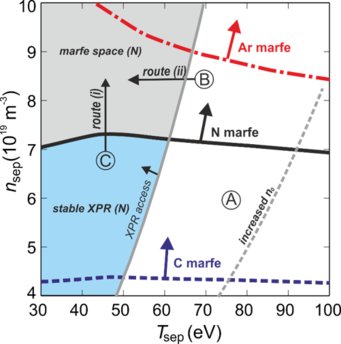Access and stability of the X-point radiator and the threshold for marfes in tokamak plasmas
Cold, dense and strongly radiating plasma volumes play an important role for power exhaust and protection of the plasma facing components in fusion devices.

Based on particle and energy balances, a reduced model was derived for the occurrence of stable and unstable X-point radiators (XPR). In its stable form, the XPR occurs in diverted tokamak plasmas on closed magnetic flux surfaces near the magnetic X-point where it can radiate up to 50 % of the heating power and lead to ELM suppression at the cost of a moderate confinement loss. When the XPR becomes unstable, a marfe forms, which is a precursor of the density limit and of harmful disruptions in tokamaks. The model results compare well with experimental observations and with results from SOLPS-ITER simulations. Altogether, this leads to a physical picture of the underlying processes. The parameter dependencies found may guide XPR control and disruption avoidance schemes (see figure).
U. Stroth et al Nucl. Fusion 62 (2022) 076008
https://doi.org/10.1088/1741-4326/ac613a
